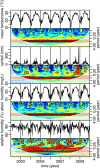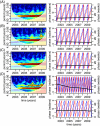Climatic-driven seasonality of emerging dengue fever in Hanoi, Vietnam
- PMID: 25323458
- PMCID: PMC4287517
- DOI: 10.1186/1471-2458-14-1078
Climatic-driven seasonality of emerging dengue fever in Hanoi, Vietnam
Abstract
Background: Dengue fever (DF) has been emerging in Hanoi over the last decade. Both DF epidemiology and climate in Hanoi are strongly seasonal. This study aims at characterizing the seasonality of DF in Hanoi and its links to climatic variables as DF incidence increases from year to year.
Methods: Clinical suspected cases of DF from the 14 central districts of Hanoi were obtained from the Ministry of Health over a 8-year period (2002-2009). Wavelet decompositions were used to characterize the main periodic cycles of DF and climatic variables as well as the mean phase angles of these cycles. Cross-wavelet spectra between DF and each climatic variables were also computed. DF reproductive ratio was calculated from Soper's formula and smoothed to highlight both its long-term trend and seasonality.
Results: Temperature, rainfall, and vapor pressure show strong seasonality. DF and relative humidity show both strong seasonality and a sub-annual periodicity. DF reproductive ratio is increasing through time and displays two clear peaks per year, reflecting the sub-annual periodicity of DF incidence. Temperature, rainfall and vapor pressure lead DF incidence by a lag of 8-10 weeks, constant through time. Relative humidity leads DF by a constant lag of 18 weeks for the annual cycle and a lag decreasing from 14 to 5 weeks for the sub-annual cycle.
Conclusion: Results are interpreted in terms of mosquito population dynamics and immunological interactions between the different dengue serotypes in the human compartment. Given its important population size, its strong seasonality and its dengue emergence, Hanoi offers an ideal natural experiment to test hypotheses on dengue serotypes interactions, knowledge of prime importance for vaccine development.
Figures




References
-
- Bhatt S, Gething PW, Brady OJ, Messina JP, Farlow AW, Moyes CL, Drake JM, Brownstein JS, Hoen AG, Sankoh O, Myers MF, George DB, Jaenisch T, William Wint GR, Simmons CP, Scott TW, Farrar JJ, Hay SI. The global distribution and burden of dengue. Nature. 2013;496:504–507. doi: 10.1038/nature12060. - DOI - PMC - PubMed
-
- Tien TKN, Ha DQ, Hien TK, Quang LC. Predictive indicators for forecasting epidemic of dengue/dengue haemorrhagic fever through epidemiological, virological and entomological surveillance. Dengue Bull. 1999;23:34–39.
-
- NIHE . Final Report on evaluation of communicable diseases surveillance system in Vietnam 2008. Hanoi: National Institute of Hygiene and Epidemiology; 2009.
-
- Ha DQ, Ninh TU. Virological surveillance of dengue haemorrhagic fever in Vietnam, 1987–1999. Dengue Bull. 2000;24:18–23.
Pre-publication history
-
- The pre-publication history for this paper can be accessed here: http://www.biomedcentral.com/1471-2458/14/1078/prepub
Publication types
MeSH terms
LinkOut - more resources
Full Text Sources
Other Literature Sources
Medical
Miscellaneous

